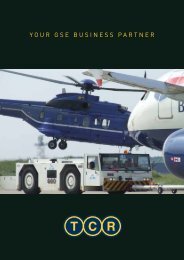WE BRING YOU SAFELY TO TAKE-OFF. - TCR Group
WE BRING YOU SAFELY TO TAKE-OFF. - TCR Group
WE BRING YOU SAFELY TO TAKE-OFF. - TCR Group
Create successful ePaper yourself
Turn your PDF publications into a flip-book with our unique Google optimized e-Paper software.
FEATURE | NOISE CONTROL<br />
“The letter says ‘we received your complaint. This was the flight<br />
which caused the noise and this was the flight path, so can see if it was<br />
on, or off track, and determine the reason why it caused a complaint’.<br />
“Such a letter might not make the airport, or aircraft, any quieter<br />
but it shows to the complainer that the airport knows what’s going on<br />
and that it has it under control. If the noise was excessive, it is dealing<br />
with it.”<br />
Stollery believes that airports that communicate openly and address<br />
issues with the public are more able to develop ‘Environmental Capacity’,<br />
which is simply the capacity to grow within the constraints of local<br />
communities.<br />
“Many airports are focused purely on noise reduction, but there’s a<br />
second element to building Environmental Capacity which is making<br />
communities more tolerant of what’s going on,” he adds.<br />
“You can set the community’s expectations if you tell people when<br />
it’s going to be noisy and when it’s not; then they are likely to tolerate<br />
it. It’s also about putting the noise in places where people expect it to be<br />
and not deviating from that. If you live under a flight path and you know<br />
it’s noisy, you can take measures to manage it.”<br />
One of Brüel & Kjær’s most recent developments is its WebTrak tool,<br />
which allows communities to go on the internet and track exactly what<br />
happened at a specific time.<br />
“You can stick in the time of day on a given date and it will replay<br />
the flight track going on around the airport. Let’s say you were woken<br />
up last night by aircraft noise, you can type in 10.10pm and see what was<br />
happening at that time.<br />
“You can even see the aircraft fl ying around the outskirts of the airport.<br />
You can also type in your address and it will measure in metres how<br />
close it came to your house.”<br />
Stollery explains that the transparency of information provided by<br />
WebTrak is a great way of developing constructive dialogues with local<br />
communities.<br />
“There’s a lower risk of people ringing up and screaming and<br />
shouting at the airport because it’s possible to explain to them why<br />
the aircraft was flying so much lower than normal. There may have<br />
been exceptional circumstances, such as weather conditions or airport<br />
maintenance. Then you can say, ‘It will be finished on Tuesday’.<br />
You’ve built awareness and understanding with the person complaining,”<br />
he says.<br />
“It’s not just about<br />
the level of decibels. In<br />
assessing the impact<br />
of noise these days, we<br />
talk more about the<br />
number of times you<br />
might be disturbed in a<br />
given location”<br />
Phil Stollery, product marketing<br />
manager for Brüel & Kjaer<br />
INNOVATION AT VANCOUVER INTERNATIONAL<br />
Vancouver is one of the major airports that has adopted the WebTrak<br />
technology as a means of enhancing its relationship with the local community.<br />
“We’ve had all the data at Vancouver for some time, but we wanted<br />
to share it with the community, so we introduced WebTrak,” says<br />
Mark Cheng, the gateway’s supervisor noise abatement and air quality.<br />
“We’ve had great feedback from local councillors telling us that<br />
their constituents love it. It works well because people find it much<br />
easier to visualise flight routes.”<br />
Cheng notes that Vancouver was the first Canadian airport to introduce<br />
the WebTrak technology as part of its comprehensive environmental<br />
management strategy. “We have to manage our noise very carefully<br />
because Vancouver is very close to densely populated urban environments<br />
and sensitive habitats,” he comments.<br />
Cheng adds that WebTrak was part of the gateway’s broader strategy<br />
to involve the local community as much as possible. For example, local<br />
community leaders are well represented on the airport’s Noise Management<br />
Committee.<br />
“They debate in an open forum alongside our regulator Transport<br />
Canada, air traffic control and the airlines. It helps us to balance the<br />
views of the community with the views of industry,” he says.<br />
Vancouver was also the first Canadian airport to install a dedicated<br />
ground run-up enclosure (GRE) designed to reduce the noise of aircraft<br />
carrying out engine maintenance at night.<br />
“They test the engines at full power in the middle of the night for 20-<br />
30 minutes at a time. In the past we had open areas to minimise it, but<br />
the noise propagated into the community,” Cheng admits.<br />
It took Vancouver three years to complete the project, including finding<br />
a suitable location and building the enormous facility, which was<br />
opened at the start of this year. Acoustic monitoring of three aircraft in<br />
the enclosure revealed major reductions in noise.<br />
“It has far exceeded our expectations. Compared to previous run-up<br />
locations, we’ve seen greater than 20 decibels of noise reduction, so it’s<br />
four times as quiet. It has reduced noise significantly in the surrounding<br />
community and the local citizens are very appreciative of having it in<br />
place.”<br />
Blast Deflectors, the Nevada-based company that designed and erected<br />
GRE at Vancouver, is at the forefront of noise-reduction technology.<br />
6 AIRSIDE INTERNATIONAL | OC<strong>TO</strong>BER 2012 WWW.AIRSIDEINT.COM



